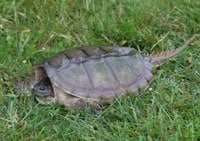By Russ Case
My June 3 blog was about reptile encounters some of my co-workers have had recently. In it I mentioned how people I work with will occasionally ask me to identify a reptile they have come across. Sometimes I have to guess based on a description, but lately they’ve been taking photos and showing them to me. That helps with the identification.
It happened again yesterday morning. Lesley Ward, who is the editor of one of our horse magazines, Young Rider, sent me the accompanying photo of a common snapping turtle (Chelydra serpentine) that showed up in her backyard in Kentucky. Her message that accompanied the photo was funny. All it said was, “Should I lock up my cats?” I suggested the best way to handle the turtle if someone wanted to try to move it – holding the rear of the shell while being careful of the long neck and jaws. Lesley said she thinks she’ll just leave it alone.
I like snapping turtles. I’ve kept two. The first was in about 1973 or so, and I was living in Birmingham, Mich. Near our house was Gilbert Lake, and one day I was patrolling its shore, as I often did, looking mainly for leopard and pickerel frogs (Rana spp.), since those were the most common herps I ever encountered at Gilbert Lake. Sometimes I’d find crayfish too.
This day I was delighted to find – sitting right in the middle of a lily pad – a hatchling common snapping turtle. I had never seen a wild snapping turtle before and immediately got very excited. I plucked the turtle off the lily pad and hurried home with it. Into an aquarium it went, and I loved watching it swim around in its tank. But our time together was destined to be short-lived, because we were scheduled to move from Michigan back to California a couple weeks after I found the turtle. So I took it back to Gilbert Lake and placed it back on top of the same lily pad from which I had removed it (well, I think it was the same one).
It was several years later that I came into possession of another common snapping turtle. I kept it in a 20-gallon aquarium that was full of water — nothing else, just water. That’s one of the nice things about keeping snapping turtles; they’re fairly easy to maintain because they are aquatic turtles and not basking turtles such as sliders, painteds, cooters, etc. So they don’t absolutely require a land area and basking spot in order to thrive. Plus they’re usually hardy eaters and seem pretty resilient to illness. You have to be careful with them due to their biting proclivities, of course, especially when they get bigger. Speaking of which, they need good-sized enclosures when they grow.
The tank mine was in was on a counter in the bathroom, so visitors to my house were always guaranteed some snapper/human interaction. Not hands-on interaction necessarily, but observation. Everyone always found the snapping turtle in the bathroom quite interesting. He ate readily and was overall an entertaining pet because he was often active and looked really neat swimming around. I had him for a few years and eventually donated him to a nature center.
There are two types of snapping turtles, the common and the alligator snapping turtle (Macroclemys temminckii). The alligator snapper is North America’s largest freshwater turtle, and it gets a lot bigger than the common snapper; about 250 pounds for an adult alligator versus about 30 pounds for an adult common snapper. Alligator snappers are such mind-bogglingly impressive animals, with their craggy, prehistoric appearance. I love coming across a gigantic alligator snapper at an aquarium or zoo, with its huge, thick head that is too big for the turtle to pull into its shell. I remember seeing a particularly impressive specimen at the Tennessee Aquarium when I was in Nashville for the 2008 International Herpetological Symposium – that one was huge! And, by the way, I highly recommend the Tennessee Aquarium if you’re ever near Chattanooga.
Aside from size if you’re looking at adults, one way to tell an alligator snapper from a common snapping turtle is by the prominent dorsal keels along the turtle’s carapace. It is these ridges, which resemble the ridges along an alligator’s back, from which the turtle gets its common name. Another difference between the two species’ shells is the alligator snapper’s shell features an extra row of scutes around the perimeter of the carapace, giving the carapace an “edged” appearance.
The alligator snapper also has a hooked beak, much more so than the common snapper. Speaking of its mouth, it’s famous for its luring feeding behavior. An alligator snapping turtle has a pink, wormlike appendage inside its mouth that the turtle, mouth agape, will wriggle to get a fish’s attention. The fish comes over to investigate what it thinks will be a tasty treat and — whammo! — another fish dinner goes down the snapper’s gullet.
They’re kinda ugly, depending on your point of view, but I think snapping turtles are particularly interesting reptiles and they’ve always had a special place in my herpetological heart. If you’ve got the space and inclination, and if doing so is legal (check local laws), I’d suggest you try keeping one at least once.





